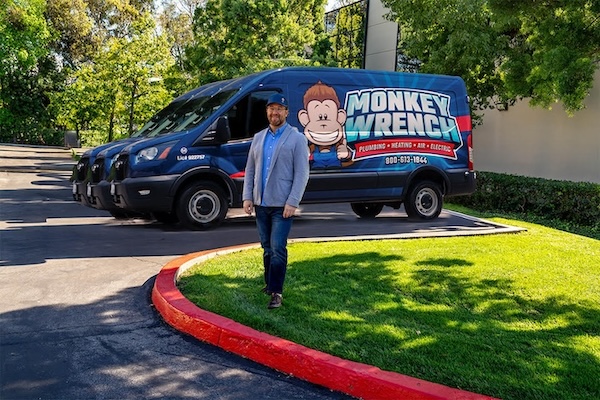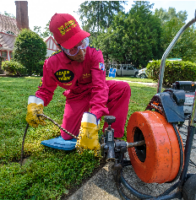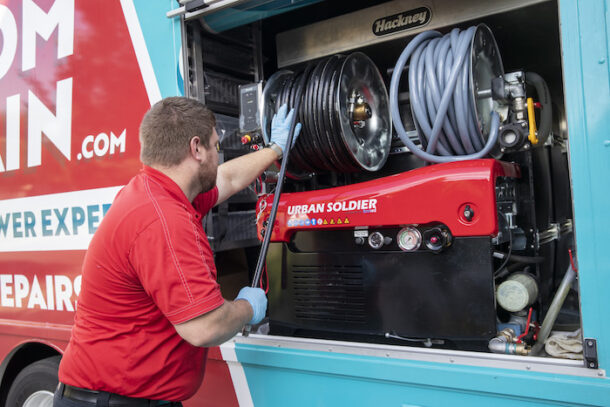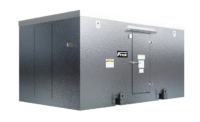Stop by the RIDGID booth to try out their latest drain cleaning, diagnostic, and pressing solutions ELYRIA, OHIO – February 11, 2025 – RIDGID®, a part of Emerson’s professional tools portfolio, announced their participation in the WWETT Show, Feb. 18-20, in Indianapolis. This year’s in-booth experience will include demos of a new game-changing handheld cordless drain Read more
Uncategorized
Stop by the RIDGID booth to try out their latest drain cleaning, diagnostic, and pressing solutions
ELYRIA, OHIO – February 11, 2025 – RIDGID®, a part of Emerson’s professional tools portfolio, announced their participation in the WWETT Show, Feb. 18-20, in Indianapolis. This year’s in-booth experience will include demos of a new game-changing handheld cordless drain cleaner, along with their latest underground technology and pressing solutions, an exclusive show meetup for industry pros with the chance to win one of three RIDGID tools, and the first chance to enter to win a spot at the 2025 RIDGID Experience.
 “WWETT will be the first place to experience our new K-46 Cordless SinkSnake™, a handheld drain cleaner that features an industry-first integrated, multi-position kickstand that alleviates the challenges of working under cramped vanities and in tubs,” said Jeff Albertini, product management director, underground technologies and licensing, RIDGID. “It’s been designed to significantly improve ergonomics when drain cleaning in sinks, tubs, vanities, and showers and our team is excited to be able to share it with those attending WWETT.”
“WWETT will be the first place to experience our new K-46 Cordless SinkSnake™, a handheld drain cleaner that features an industry-first integrated, multi-position kickstand that alleviates the challenges of working under cramped vanities and in tubs,” said Jeff Albertini, product management director, underground technologies and licensing, RIDGID. “It’s been designed to significantly improve ergonomics when drain cleaning in sinks, tubs, vanities, and showers and our team is excited to be able to share it with those attending WWETT.”
Along with the K-46, RIDGID invites tradespeople to stop by the RIDGID booth (#2605) to experience their other drain cleaning, inspection, pipe rehabilitation, and pressing tools, including these latest solutions:
o NEW SeeSnake® microDRAIN APX CSx Via™ System – This kit features the SeeSnake microDRAIN APX, an inspection camera ideal for small pipes and tight turns with a flexible push cable and compact camera head to navigate small-diameter pipes, p-traps, and narrow bends where other systems struggle. Equipped with TruSense® technology and auto-image rotation, this inspection camera provides bright, clear images with real-time angle and orientation feedback. Paired with the CSx Via, the system offers a flexible, bring-your-own-screen solution to stream, capture, and share inspection images.
o FlexShaft® KM-1004 Milling Machine – This innovative hybrid milling machine provides heavy-duty milling and a wall-to-wall clean on 1 ¼ to 4-inch pipe up to 80 feet with unmatched efficiency. With cordless freedom, plug-in capability, first ever FlexShaft cable counter, and best-in-class durability, the FlexShaft KM-1004 Milling Machine allows users to adapt to tough jobsite conditions and makes in-field serviceability effortless.
o SeeSnake Mini Pro Inspection Camera with TruSense Technology – The first reel of its kind to provide digital self-leveling without mechanical rotation to maximize uptime, the small, yet rugged Mini Pro is designed to inspect up to 200 feet of 1 ½ to 8-inch pipe with its mid-flex push cable that can navigate hard 90-degree bends. Its innovative 25 mm digital self-leveling camera head always keeps the in-pipe image upright and, when paired with a TruSenseenabled monitor, the Mini Pro delivers the industry’s best in-pipe image with superior clarity, detail and fewer blown-out areas and sections of the pipe that are too dark to see.
o K-4310 FXP™ Drum Machine – The K-4310 features an industry-first cable counter that provides real-time, in-pipe cable distance in 3 to 10-inch lines for faster locating and diagnostics. Ideal for residential and commercial plumbing and drain cleaning projects, its powerful brushless DC motor spins at 230 RPM allowing you to tackle tough jobs with less required maintenance. The battery-powered K-4310 is also the newest addition to the FXP Technology Platform, delivering cordless freedom and powerful performance.
Other RIDGID drain cleaning, diagnostic, and press tools will also be available for demo including sectional machines, drum machines, jetters, SeeSnake® camera systems and locators.
Along with product demos, RIDGID is hosting a booth meetup on Feb. 18 at 2 p.m. where industry pros will have the chance to win a K-46 SinkSnake™, K9-204+ FlexShaft® Drain Cleaning Machine or microDRAIN APX and Via Kit. Additionally, the first day of the show will kick off the RIDGID Experience 2025 and the RIDGID WWETT booth will be the first opportunity for attendees to enter for their chance to win a spot on the eighth annual, all-expenses-paid trip to RIDGID headquarters. Throughout the show, attendees can also scan their badge to enter to win one of three K9-102+ FlexShaft Drain Cleaning Machines.

What started as a fairly innocuous Contractor Spotlight turned into something much deeper. For Yossi Wachtel, president of Monkey Wrench Plumbing, Heating, Air & Electric, Los Angeles, the impact of the LA fires just hits different. “When the fire started, our typically overbooked dispatch board dropped to 25% capacity, but Los Angeles will rebuild so Read more
 What started as a fairly innocuous Contractor Spotlight turned into something much deeper. For Yossi Wachtel, president of Monkey Wrench Plumbing, Heating, Air & Electric, Los Angeles, the impact of the LA fires just hits different. “When the fire started, our typically overbooked dispatch board dropped to 25% capacity, but Los Angeles will rebuild so that’s not what keeps me up at night. What really shakes me is hearing a customer say, ‘Why fix the plumbing when we might not have a house to come back to?’ That’s not just a cancelled appointment, that’s a neighbor facing the unthinkable,” says Wachtel.
What started as a fairly innocuous Contractor Spotlight turned into something much deeper. For Yossi Wachtel, president of Monkey Wrench Plumbing, Heating, Air & Electric, Los Angeles, the impact of the LA fires just hits different. “When the fire started, our typically overbooked dispatch board dropped to 25% capacity, but Los Angeles will rebuild so that’s not what keeps me up at night. What really shakes me is hearing a customer say, ‘Why fix the plumbing when we might not have a house to come back to?’ That’s not just a cancelled appointment, that’s a neighbor facing the unthinkable,” says Wachtel.
Monkey Wrench’s service area—Pacific Palisades, Santa Monica, West Hollywood, West LA, Altadena—has been affected. “These aren’t just dots on our dispatch map, they are homes where we’ve fixed leaks, installed water heaters, and built relationships over years. Now many of those same homes are in harm’s way. These aren’t just statistics on a news report. These are people we live with, shop at the same supermarkets with, go to the gym with, and work with.”
But what really matters to Wachtel is that Monkey Wrench is a community business, and right now the community needs something different than plumbing services. They need support, resources, and reassurance. “So, while our phones might be quieter today, our commitment to this community has never been louder. We’re here for whatever our neighbors need—whether that’s emergency plumbing assistance or just someone who knows the area and can point them toward help. This isn’t about business anymore. It’s about being there for our community when they need us most. To all our customers, employees, and fellow Angelenos: Stay safe. Material things can be replaced, lives cannot,” says Wachtel.
The Spotlight
Yossi Wachtel’s path to plumbing was anything but traditional. After studying in rabbinical college in Australia, Wachtel found himself drawn to the trades through construction work. What started as painting closets evolved into a fascination with the mechanics of plumbing. In 2007, Wachtel moved to California and founded Monkey Wrench with just one truck. Today, we operate nearly 50 trucks and employ around 100 team members, serving residential customers throughout Los Angeles.
 “I discovered plumbing in my late twenties while working in property management. What captivated me wasn’t just the technical aspects; it was the opportunity to be someone’s hero. Every call was a chance to solve problems and make a real difference in people’s lives. After three years learning the trade, I took the leap to start my own company,” recalls Wachtel.
“I discovered plumbing in my late twenties while working in property management. What captivated me wasn’t just the technical aspects; it was the opportunity to be someone’s hero. Every call was a chance to solve problems and make a real difference in people’s lives. After three years learning the trade, I took the leap to start my own company,” recalls Wachtel.
Wachtel has always had that eye for business. “I’ve always been entrepreneurial—I started my first business at age seven,” says Wachtel. “But with plumbing, I saw a clear need for professionals who could deliver exceptional customer service.”
And, because Wachtel is an ordained rabbi, he uses what he’s learned in his plumbing business. “While I chose plumbing over rabbinical work, I still apply those teachings about ethics and service to others in how we run our business.
The Narrative, Reworked
According to Wachtel, and many others enjoying a career in the trades, college isn’t the only path to success. He says that the trades offer an incredible opportunity to build a rewarding career without student debt. “At Monkey Wrench, we have technicians earning six-figure incomes, and more importantly, they’re making a real difference in people’s lives. Plus, you’ll never have to worry about your job being outsourced or replaced by Artificial Intelligence,” says Wachtel.

According to Wachtel, the industry should partner more with high schools, create clear career advancement paths, showcase modern technology and tools, highlight success stories and emphasize the entrepreneurial opportunities. “We need to change the narrative about trade careers. It’s not just about unclogging toilets—it’s about problem-solving, using advanced technology, and helping people.”
Mentor and Relation Ships
Wachtel says that his greatest mentors have come through Nexstar Network. “They taught me that being a great plumber isn’t enough; you need to be a great business person too,” says Wachtel.
Not only did Wachtel find mentorship through Nexstar, he says that joining Nexstar was a game-changer for us. “I made a significant investment in that first-year membership when I could barely make payroll—it was terrifying but turned out to be the best decision I’ve ever made. Continuous education isn’t just important; it’s essential. The industry evolves constantly, and if you’re not learning, you’re falling behind.”

Today, he’s passionate about mentoring others, especially through the company’s developing trade academy, which would help young people discover and develop their potential in the trades. Wachtel says it’s becoming the next big mission at Monkey Wrench. “Nothing brings me more joy than seeing our team members buy their first homes or achieve personal milestones through their careers with us.”
The biggest challenge is finding the right people who share the vision for exceptional service. But for Wachtel, the rewards far outweigh the challenges. “Recently, one of our employees became the first person in three generations of his family to buy a home. Those moments—seeing our team members grow and succeed—that’s what makes this all worthwhile,” says Wachtel.

In fact, one of Monkey Wrench’s team members celebrated their 10-year anniversary with the company. “These milestones remind me why we do what we do. It’s about creating opportunities and changing lives through this amazing trade,” says Wachtel.
While Wachtel is proud of the community he’s created at Monkey Wrench, the company is in good hands. Both of Wachtel’s sons work for the business—one is the Operations Manager, and the other works in the marketing department. “It’s incredible watching them grow into their roles and bring fresh perspectives to the company. While I hope they’ll continue the legacy, I want it to be their choice. They need to earn it and want it,” says Wachtel.
Wachtel’s Top Tips for Starting a Business
• Perfect your craft before going solo
• Join a best practices organization (it changed everything for us)
• Focus on building systems, not just fixing pipes
• Invest in your people’s growth
• Stay true to your business model—avoid the temptation of “shiny objects”

For many homeowners, when it comes to home maintenance, there is nothing glamorous about drainage systems and sewer lines. However, they are an important aspect that keeps a property in excellent shape. With time, these systems usually collect different types of junk, such as leaves, soap scum, grease, and others. Left unchecked, it can cause Read more
For many homeowners, when it comes to home maintenance, there is nothing glamorous about drainage systems and sewer lines. However, they are an important aspect that keeps a property in excellent shape. With time, these systems usually collect different types of junk, such as leaves, soap scum, grease, and others. Left unchecked, it can cause unpleasant odors, slow drains, or blockage. However, with pressure washing and the right tools, you can quickly keep your drainage systems and sewer lines clean and functional.

Why pressure washing
Pressure washing isn’t just for cleaning your patios or driveways. It is an excellent method for cleaning drains and sewer lines because it utilizes high-pressure water to remove stubborn debris and grime. Unlike chemical cleaners or snaking, pressure washing can wash the inner pipes clean and restore their full capacity. Additionally, it is also eco-friendly when used with biodegradable detergents or plain water.
What do you need?
Before embarking on the pressure washing cleaning process, these tools are the essentials that you will need:
- A pressure washer of at least 3,000 PSI with a flow rate of 4 gallons per minute.
- Sewer jetting attachment is a unique tool that is made to clean sewer lines and pipes.
- Protective gear such as waterproof boots, safety goggles, and gloves are crucial. You do not want any surprises.
- Access to a drain opening or sewer line cleanout port.
Tips to succeed
To ensure the cleaning process is a success, the following are some tips to help guide you.
- Fragile or older pipes might not be capable of withstanding high-pressure washing. You must proceed with caution to avoid damages or consult with a professional
- Use the right nozzle. Sewer jetting nozzles usually come in different configurations and sizes. For a better result, ensure you choose one that matches the diameter of your pipes.
- When dealing with grease buildup, it is best to opt for a biodegradable degreaser before pressure washing. This can help you break down the residue.
- Always perform regular maintenance. You should not wait for a clog to occur. Periodic pressure washing ensures your drains and sewer lines are in top shape and saves you costly repairs.
Mistakes to avoid
- Always inspect the areas and remove loose debris before pressure washing. You might risk pushing the mess further into the system if you don’t do so.
- High-pressure washing is quite powerful and can damage pipes when used excessively. Stick to moderate settings unless absolutely required.
- Sewer lines can harbor bacteria, and high-pressure water can cause injuries when mishandled.
Calling the professionals
Though pressure washing is effective for minor blockages and regular maintenance, there are instances when a professional touch is needed. When dealing with tree root inclusion, recurring clogs, or complete sewer line backup, it is crucial you call a licensed plumber with specialized equipment.
Endnote
Cleaning your drainage systems and sewer lines is an essential chore and with a pressure washer and the right approach, you can handle buildup and clogs. Remember to keep these tips in mind when embarking on a pressure washing cleaning process.

Leading branding agency for the trades allows registration to historically client-exclusive event Lemon Seed Marketing, a leading branding and marketing agency for the home service industry, is hosting its fifth annual Lemon Seed Conference Jan. 26-29 in Lufkin, Texas. While the conference has typically been exclusive to Lemon Seed clients, this year’s event, titled “Get Read more
Leading branding agency for the trades allows registration to historically client-exclusive event
Lemon Seed Marketing, a leading branding and marketing agency for the home service industry, is hosting its fifth annual Lemon Seed Conference Jan. 26-29 in Lufkin, Texas. While the conference has typically been exclusive to Lemon Seed clients, this year’s event, titled “Get a Clue: Keys to Unlocking the Marketing Mystery,” is open to all home service businesses.

“Our first four conferences were private events for existing clients, but this year we are opening our event to all home service owners and marketers seeking an experience that combines education, inspiration and fun,” said Crystal Williams, founder and lead strategist at Lemon Seed Marketing. “My family has owned an HVAC company since 1974, and I understand how much of a lift marketing can be for owners to tackle on their own, which is why we are focused on helping companies like the one my family owns.”
Lemon Seed has continued to evolve and expand its branding services thanks to Williams’ close work with Emily Fleniken, an experienced branding professional and partner at Lemon Seed. As an extension of this, the marketing and branding conference will provide business owners and their teams guidance to implement best practices and trends into a promotional plan for their own company. Sessions and workshops will focus on finance, operations, branding, community, leadership, marketing and advertising. In addition to presentations from Williams and Fleniken, other conference sessions and workshops include:
- Kelly Schols, success mentor and author – “Mentor Your Successor”
- Trey McWilliams, McWilliams Heating, Cooling and Plumbing – “Financial KPIs you must track in 2025
- Power Selling Pros founder and industry leader Brigham Dickinson – “How Technicians Get Homeowners to Buy More Without Selling”
- Industry Hot Topics Round Table
- CSR Academy, an exclusive, 90-min workshop designed to help business owners unlock the full potential of their Call Center and CSRs
- On-site tour of the McWilliams facilities, including their call center, training lab, warehouse and meeting spaces
Fleniken says the week promises to be an exciting mix of good information and good times. By mixing informational sessions with networking opportunities, she hopes attendees leave with actionable ideas and the enthusiasm to implement them.
“The ultimate solution is to make the path to success seem less of a secret by developing actionable strategies,” Fleniken said. “And that is what this conference is all about: offering an opportunity to not only learn firsthand from experts in the field, but also to have plenty of fun networking time with peers to compare notes and learn from each other.”
For more information or to sign up for the conference, please visit: www.lemonseedmarketing.com/lsm-conference-2025-register.
For more information about Lemon Seed Marketing, please visit: www.lemonseedmarketing.com.

The latest heat pump technologies increase application range, empowering electrification and decarbonization Sophisticated digital platforms and smart technologies advance digitization, help optimize building performance and reach net zero goals Johnson Controls (NYSE: JCI), the global leader for smart, healthy and sustainable buildings, will highlight key trends facing the HVAC industry and solutions to meet evolving customer Read more
- The latest heat pump technologies increase application range, empowering electrification and decarbonization
- Sophisticated digital platforms and smart technologies advance digitization, help optimize building performance and reach net zero goals
Johnson Controls (NYSE: JCI), the global leader for smart, healthy and sustainable buildings, will highlight key trends facing the HVAC industry and solutions to meet evolving customer needs at the leading trade show for HVACR professionals, the AHR Expo, Jan. 22-24, 2024. To assist contractors and business owners in navigating the upcoming year, Johnson Controls will present innovative solutions that improve efficiency, promote electrification, advance digitization and ensure compliance with refrigerant regulations.
“The critical conversations taking place at this year’s conference will focus on the major transformations in our industry, driven by the demand for smart, healthy and sustainable buildings,” said Lei Schlitz, president, Global Products, Johnson Controls. “The most significant commitment any commercial or residential property can make is to incorporate more efficient and electrified systems into their building, all digitally connected for increased insight into system performance. This is more important than ever to address the world’s most pressing challenges.”
Greater Efficiency
The HVAC industry’s focus on sustainability continues to grow. The speed of this growth is driven by multiple factors, including governmental energy efficiency regulations, corporate initiatives and an increasing number of environmentally conscious consumers. In fact, according to a recent study by Johnson Controls and Forrester Consulting, one-third of respondents said they need to accelerate their efforts to meet pending net zero goals.
For homeowners, Johnson Controls offers numerous options for hybrid system including the YORK® YH5 15.2 SEER2 Single-Stage Heat Pump and Y92E 97% AFUE 2-stage furnace that allows homeowners to use the most efficient fuel source based on temperature conditions. As the primary heating and cooling source, the YH5 heat pump is optimized to meet 25C tax incentives through the IRA. During the few times a year when temperatures are too low for efficient electric heating, the Y92E furnace provides efficient backup heating and is also optimized to meet 25C eligibility requirements.
To help hyperscale data centers and improve cooling efficiency while maintaining uptime, Johnson Controls developed solutions that reduce energy consumption and total cost of ownership. Specified for the unique needs of mission-critical applications, the YORK YVAM Air-Cooled, Magnetic-Bearing Centrifugal Chiller is one of the most efficient options for data center cooling.
Widespread Electrification
Electrification continues to gain momentum due to the acceleration toward decarbonization and the use of renewable energy sources. At the same time, incentives such as the IRA are making high-efficiency HVAC systems, including heat pumps, more accessible to a wider population. These factors are making it easier for contractors to talk to customers about new systems and get buy-in.
According to Schlitz, “Electrification is a critical pillar of decarbonization, and innovative heat pumps are essential to strategically electrify heating and cooling. Johnson Controls is at the forefront of evolving heat pump technology to push the limits of what is possible and reduce the use of inefficient backup sources even in the coldest climates.”
For example, Johnson Controls-Hitachi Air Conditioning will soon launch a new variable refrigerant flow (VRF) cold-climate heat pump. The air365 Max Heat Pump is designed to efficiently cool and heat buildings in cold climates down to -22°F for reduced energy costs year-round.
In partnership with the DOE Office of Manufacturing and Energy Supply Chains, Johnson Controls recently announced an initiative to accelerate the production of domestic heat pump manufacturing – including cold climate air source heat pumps – by expanding three of its U.S.-based factories. Combined, these facilities will be able to produce approximately 200,000 electric heat pumps per year. This substantial volume will help drive energy affordability and energy security, while helping combat climate change and creating new jobs.
Advanced Digitalization
Homeowners and building managers are increasingly recognizing the advantages of integrating smart technology into building systems. In commercial buildings, operational technology (OT) systems, including chillers, BAS & Controls, video monitoring, and access control, as well as information technology (IT) systems and external sources such as weather forecasts and utilities, are seamlessly connected using Internet of Things (IoT) and secure cloud technology.
The suite of apps offered by Johnson Controls OpenBlue Enterprise Manager continuously monitors data streams, offering users informative dashboards that display system status and health. Leveraging AI, advanced analytics, digital twin technology, and insights from expert engineers, these apps provide valuable recommendations to customers to save energy, minimize costs, reduce carbon emissions, improve indoor air quality and enhance occupant comfort. The OpenBlue suite also incorporates predictive analytics and remote diagnostics, enabling system condition assessment, anticipation of service requirements, and accelerated troubleshooting. This proactive approach effectively mitigates failures, minimizes unplanned downtime, and prevents inconvenient – and costly – emergency repairs.
Verdantix, an independent industry analyst firm, recently recognized OpenBlue as a market-leading Energy Management Software. Additionally, OpenBlue’s strategic acquisitions, including FM Systems, a leading IWMS provider, further strengthen its ability to support customers on their path towards intelligent, sustainable, and healthy buildings.
Low-GWP Refrigerants
The most significant phase to date of the American Innovation and Manufacturing (AIM) Act, which mandates an 85% reduction in hydrofluorocarbon (HFC) gases by 2036, went into effect at the beginning of January 2024. This phase reduces HFC production by an additional 30% (40% total reduction), directing the industry to transition to low-GWP refrigerants.
While Johnson Controls is helping industry professionals adapt to the refrigerant transition through its world class technical training and educational resources (on-line and in person), the company is adding product features that make working with these new low-GWP refrigerants even safer and easier to service. For instance, YORK commercial rooftop units utilizing R-454B refrigerant will offer a new refrigerant detection system (RDS) to detect refrigerant leaks within the unit cabinet. The RDS will be required by code in certain applications and optional in others, which will help customers understand when it is required. Johnson Controls has also developed a unique and innovative RDS Calculator tool that will be available in both the product selection tool and in the Ducted Systems Solutions App.
Johnson Controls has added additional ultra-low GWP refrigerant options to its applied products. For instance, the YORK YVWH Water-to-Water Dual Variable-Speed Screw Heat Pump was the first screw heat pump in North America to use R-1234ze refrigerant. R-1234ze has an ultra- low GWP of 1, which enables the YVWH to far exceed the EPA’s refrigerant regulations that go into effect starting Jan. 1, 2025.
To learn more, visit Johnson Controls at the AHR Expo at booths S6236 and S7529 or go to https://www.johnsoncontrols.com/events/ahr.
